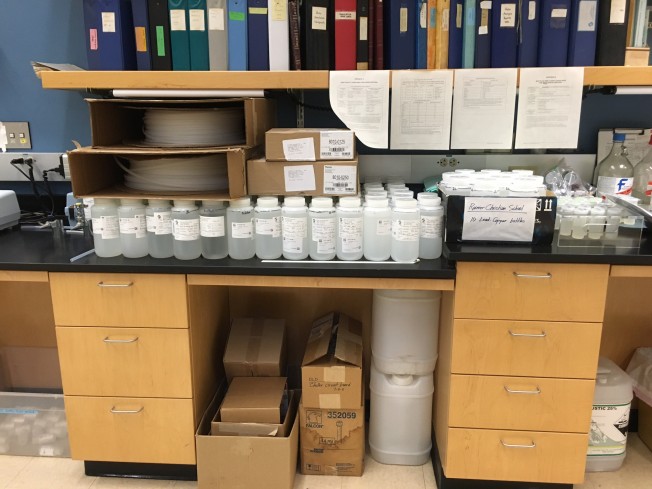(UPDATED 8:11 PM with link to information now posted on SPU website)
By Tracy Record
West Seattle Blog editor
“We think our water’s safe. Having said that, we’re going to make sure there’s no cause for alarm.”
So said Andy Ryan from Seattle Public Utilities when we talked with him a short time ago about a new round of water testing and investigation that SPU has launched because of a situation in Tacoma involving lead.
The two cities’ water systems are NOT linked, but the situation that Tacoma uncovered MIGHT also be happening in a small part of Seattle’s service area, so SPU is advising a specific precaution: Until they find out for sure if the lead problem is happening anywhere here too, any time you have NOT run the water in your home or business for six hours, turn on a faucet and run it for two minutes before using it.
This is NOT just a West Seattle thing, and NOT related to the rust/sediment situation that led to the flushing that’s been happening here (just last night, we were out with the flushing crew and were starting to work on that update, when we found out about this and found ourselves writing this completely different water-system story instead).
What Tacoma has been doing, Ryan explained, is looking for galvanized-steel service pipes in their system that are connected to water mains with “a piece of lead pipe called a gooseneck.” He says Tacoma, Seattle, and many other cities have some of those goosenecks because their systems are so old. But they don’t know exactly where those goosenecks are – many are near older houses “built before good records were kept,” explained Ryan.
SPU DOES know where the galvanized lines connect to the water mains. There will soon be a map on the SPU website showing where those are – about 2,000 in Seattle, they believe. That will help them accelerate looking for the goosenecks. Ryan said there had already been an effort to replace them when crews found them, and they’ve been trying to find ways to step up the search. Tacoma, he explains, came up with a way to test water inside galvanized-pipe areas to look for heightened lead levels, and that’s what led to the current concerns, after a handful of samples came back. “As soon as we learned about this, we immediately started to figure out what that meant for our system,” Ryan told WSB. “Short answer is – we don’t know (yet).” So they’re launching the same kind of testing in the galvanized lines to see what turns up.
It should be noted, though, that Seattle Public Utilities has already been routinely testing its water for lead and other undesirable metals such as copper, “greatly exceed(ing) regulators’ standards.”
We visited the lab (March photo above) for our recent story about “who’s watching your water?” related to the ongoing effort to reduce the incidences of “brown water” here. (And yet again, if you haven’t followed our coverage, “brown water” does NOT involve lead – it’s basically rust that’s stirred up in the cast-iron water mains, and even visible levels of it are not a health risk. Lead is basically invisible. It has not turned up in Seattle tests, Ryan says.)
Meantime, they’re hoping to get some samples back “really quickly” to see if what Tacoma found “is applicable here.” Since the locations of possible problems aren’t known yet, “we are asking everyone to just be extra cautious – run your water for two minutes if it’s been sitting in the pipe for more than six hours.” That’s being advised out of “an abundance of caution,” he stresses. “Prior to hearing back from Tacoma, we had not considered, nor had regulators considered, these galvanized pipes and gooseneck fittings to be an issue.” There are some differences between how Tacoma and Seattle run their systems, he notes, particularly the treatment methods, which could lead to a different level of corrosion in their pipes, in turn meaning that what’s detected there will NOT turn up here. But they have to find out.
So:
Until you hear otherwise from SPU, follow the “run the water for two minutes after it’s been in the pipes for six hours” advice TFN. Keep watch for a map on their website showing the “general areas of the 9,000 galvanized service lines, maybe four percent of all our service lines. 2,000 of those might have the gooseneck fittings.” (Those fittings used lead because it was more flexible and less likely to break, he explained.)
If you have questions – SPU already has a special phone number: 206-684-5800.
When the aforementioned map, and any other information, is online, we’ll link that here too.
BOTTOM LINE: For now, SPU is asking *everyone* to run their water for two minutes after six hours of non-use. (So, when you wake up, and when you get home from work, if your residence is empty during the day.) That will soon be narrowed down to the 9,000 or so customers who are connected to water mains via galvanized-steel piping. The lead goosenecks are only believed to be in use for a quarter of those connections, but that will be the most difficult thing for SPU to narrow down.
8:11 PM UPDATE: SPU’s website now has information, linked from its left sidebar, which points you to this page. No location information yet on where the city believes it has the galvanized piping that could be connected to the aforementioned lead-containing gooseneck fittings, but it promises, “More information about potentially impacted homes will be posted here soon.”


| 39 COMMENTS